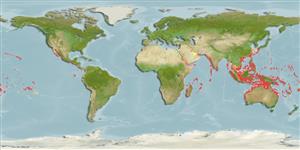Common names from other countries
Environment: milieu / climate zone / depth range / distribution range
Ecologia
marinhas associadas(os) a recifes; intervalo de profundidade 0 - 60 m (Ref. 128797), usually 14 - 45 m (Ref. 37816). Tropical; 22°C - 28°C (Ref. 27115); 32°N - 32°S
Indo-Pacific: Red Sea to Panama and Columbia, north to southern Japan and the Hawaiian Islands, south to the Lord Howe and Austral islands.
Tamanho / Peso / Idade
Maturity: Lm ? range ? - ? cm
Max length : 32.0 cm TL macho/indeterminado; (Ref. 30573); common length : 26.5 cm SL macho/indeterminado; (Ref. 37816); peso máx. Publicado: 61.16 g (Ref. 124708)
Espinhos dorsais (total): 1 - 4; Raios dorsais moles (total): 52-56; Espinhos anais 1; Raios anais moles: 46 - 55.
Inhabits barren, open areas of outer reef slopes. Occurs in pairs over rocks or sandy areas adjacent to reefs (Ref. 5213). Usually lives in a burrow of their own construction, often under a surface rock on sand (Ref. 48635). Has pelagic stage to at least 5 cm, hence smaller juveniles are not seen on the substrate (Ref. 48635). Benthic and Benthopelagic (Ref. 58302). Marketed fresh (Ref. 9119).
Life cycle and mating behavior
Maturidade | Reprodução | Desova | Ovos | Fecundidade | Larvas
Dooley, J.K., 1978. Systematics and biology of the tilefishes (Perciformes: Branchiostegidae and Malacanthidae) with descriptions of two new species. NOAA Tech. Rep. NMFS Circ. No. 411:1-78. (Ref. 8991)
Categoria na Lista Vermelha da IUCN (Ref. 130435)
CITES (Ref. 128078)
Not Evaluated
Ameaça para o homem
Harmless
Utilização humana
Pescarias: espécies comerciais; Aquário: Espécies comerciais
Mais informação
Nomes comunsSinónimosMetabolismoPredadoresEcotoxicologiaReproduçãoMaturidadeDesovaFecundidadeOvosDesenvolvimento dos ovos
ReferênciasAquaculturaPerfil para aquaculturaEstirpesGenéticaElectrophoresesHereditariedadeDoençasProcessamentoMass conversion
Ferramentas
Relatórios especiais
Descarregue XML
Fontes da internet
Estimates based on models
Preferred temperature (Ref.
115969): 24.5 - 29, mean 27.9 (based on 1154 cells).
Phylogenetic diversity index (Ref.
82804): PD
50 = 0.6250 [Uniqueness, from 0.5 = low to 2.0 = high].
Bayesian length-weight: a=0.00537 (0.00236 - 0.01221), b=3.03 (2.82 - 3.24), in cm Total Length, based on LWR estimates for this (Sub)family-body shape (Ref.
93245).
Nível Trófico (Ref.
69278): 3.5 ±0.37 se; based on food items.
Fishing Vulnerability (Ref.
59153): Low vulnerability (22 of 100).
